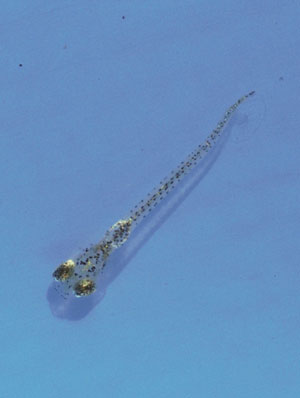Many aquatic animals must adjust their own movement to compensate for displacements induced by the flow of the surrounding water. These flow-induced displacements can most easily be detected as visual whole-field motion with respect to the animal’s frame of reference. In spite of this, effective navigation against oncoming flows (a behavior known as rheotaxis) is frequently observed even in the absence of visual cues. How animals achieve this task, and its underlying sensory basis, is still unknown.

Figure: Six day old zebrafish larva
In a recent study an international team of three laboratories – the groups of Belen Elgoyhen in Buenos Aires, Hernan Lopez-Schier in Munich and Florian Engert in Boston – has joined efforts to elucidate the role of the hair cells of the lateral line in this remarkable behaviour. The combined expertise of all team members allowed the identification of the neuromast organ as a pivotal player, and the group of Florian Engert developed this idea further into an elegant, purely behavioural, study that uncovered the precise algorithms that zebrafish use for rheotaxis in darkness.
First, they could show that larval zebrafish (Danio rerio) perform rheotaxis by using flow velocity gradients as navigational cues. They presented behavioral data that support a novel algorithm based on such local velocity gradients that are used by the animal to efficiently avoid getting dragged by flowing water. Specifically, it was shown that fish use their mechanosensory lateral line to first sense the curl (or vorticity) of the local velocity vector field to detect the presence of flow and, second, measure its temporal change following swim bouts to deduce flow direction. These results reveal an elegant navigational strategy based on the sensing of flow velocity gradients and provide a comprehensive behavioral algorithm, also applicable to robotic design, that generalizes to a wide range of animal behaviors in moving fluids.
Reference
A novel mechanism for mechanosensory-based rheotaxis in larval zebrafish. Oteiza P, Odstrcil I, Lauder G, Portugues R, Engert F. Nature. 2017 Jul 27;547(7664):445-448. doi: 10.1038/nature23014. Epub 2017 Jul 12.


































